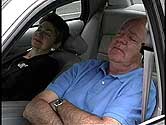Sleepy Drivers Are Dangerous Drivers
On holiday weekend, experts note vision problems, fatigue as deadly as bad road conditions, drunk driving.
|
E-mail this article
Subscribe to news
Printer friendly version
|

(SOURCE: The Vision Council/National Sleep Foundation, news release, Aug. 20, 2008)
SATURDAY, Aug. 30 (HealthDay News) -- This Labor Day weekend, the Vision Council and National Sleep Foundation are warning people of the dangers of driving with poor vision or while drowsy.
These two rarely recognized driving hazards are just as deadly as poor road conditions and drunk driving.
In a recent survey, Shedding Light on Driving in the Dark, 38 percent of respondents complained of eyestrain, 34 percent of dry or tired eyes, 25 percent of fatigue, and 18 percent of the inability to focus while driving at night. And both the National Highway Traffic Safety Administration (NHTSA) and the National Safety Council cite the fatality rate at night to be three times higher than the daytime rate.
More than 11 million Americans are living with uncorrected vision problems, which can significantly diminish the ability to drive safely.
"We rely on our eyes every time we step into a car; especially our peripheral vision, depth perception, and focusing skills," Ed Greene, CEO of the Vision Council, said in a council news release. "This link between vision and driving makes it essential for motorists to take steps to maintain healthy vision, just as they take other safety precautions on the road."
Another survey, the 2008 Sleep in America Poll, found that 64 percent of drivers who work 30 hours per week or more have driven a vehicle while feeling drowsy in the past year, and 36 percent have actually fallen asleep at the wheel.
Like alcohol, sleepiness can affect vision, slow reaction time, decrease awareness, and increase the risk of crashing. Young people, men, shift workers, commercial drivers and people with untreated sleep disorders are at especially high risk of being involved in sleep-related crashes.
"Most people are aware of the dangers of drinking and driving but are unaware that driving drowsy can be just as fatal," Darrel Drobnich, chief program officer at the National Sleep Foundation, said in a news release from the foundation. "In fact, traffic safety and sleep experts believe that drowsy driving is much more common than even federal statistics indicate."
The Vision Council and National Sleep Foundation recommend the following to enhance your vision and prevent drowsy driving:
- Get regular eye exams.
- Always wear prescription glasses and make sure they are clean.
- Wear anti-reflective (AR) lenses to eliminate glare.
- Get 7 hours to 9 hours of sleep a night.
- During long trips, stop or switch drivers approximately every 100 miles or two hours.
- Watch for warning signs of fatigue, including impaired reaction time and judgment; decreased performance, vigilance, and motivation; trouble focusing, keeping your eyes open, or keeping your head up; daydreaming and wandering thoughts; yawning or rubbing your eyes repeatedly; drifting from your lane; tailgating and missing signs or exits; feeling restless, irritable, or aggressive; or feeling the need to roll down the window or turn up the radio to stay alert. If you experience any of these warning signs, pull over at a safe place immediately for a short nap or find a place to stay for the night.
More information
The National Highway Traffic Safety Administration has more about traffic safety.
Copyright © 2008 ScoutNews, LLC. All rights reserved. 
HealthDayNews articles are derived from various sources and do not reflect federal policy. healthfinder.gov does not endorse opinions, products, or services that may appear in news stories. For more information on health topics in the news, visit the healthfinder.gov health library.